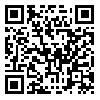Volume 25, Issue 10 (Jun 2018)
JSSU 2018, 25(10): 819-827 |
Back to browse issues page
Download citation:
BibTeX | RIS | EndNote | Medlars | ProCite | Reference Manager | RefWorks
Send citation to:



BibTeX | RIS | EndNote | Medlars | ProCite | Reference Manager | RefWorks
Send citation to:
Eftekhary F, Payandeh M, Savadi M. Evaluation of the free moment parameter during walking in patients with multiple sclerosis
. JSSU 2018; 25 (10) :819-827
URL: http://jssu.ssu.ac.ir/article-1-3690-en.html
URL: http://jssu.ssu.ac.ir/article-1-3690-en.html
Abstract: (3964 Views)
Introduction: Patients with multiple sclerosis (MS) suffer from inabilities such as weakness and muscle fatigue. This is due to the demyelination, disorder of the central nervous system, axons and oligodendrocytes. Free moment assess is known as important descriptor to investigate disorders with balance when walking. The purpose of this study was to evaluate the free moment in during walking that represents balance disorders in patients with multiple sclerosis.
Methods: This study was a cross sectional study, that was performed on 30 people; they were divided into two groups, the patients with multiple sclerosis (n = 15) and healthy groups (n = 15). The free moment component was measured in all the participants while they were walking throughout the four moments of initial heel contact, loading response, mid stance, and terminal stance of the stance phase with a frequency of 1000 Hz, by means of force plates. The data of the study were analyzed by an independent t-test (p < 0.05).
Results: The results showed that the individuals with multiple sclerosis at the time of initial heel contact have been greater free moment than to healthy control. That the free moment difference between the two groups was statistically significant (p = 0.02). In addition, the results this study showed that the three other free moments in the stance phase there was no significant difference (p >0.05).
Conclusion: The results of this study can be concluded that most differences in postural sway when walking between subjects with multiple sclerosis and healthy occurs at the start of the stance phase of gait, exactly at the time of initial heel contact.
Methods: This study was a cross sectional study, that was performed on 30 people; they were divided into two groups, the patients with multiple sclerosis (n = 15) and healthy groups (n = 15). The free moment component was measured in all the participants while they were walking throughout the four moments of initial heel contact, loading response, mid stance, and terminal stance of the stance phase with a frequency of 1000 Hz, by means of force plates. The data of the study were analyzed by an independent t-test (p < 0.05).
Results: The results showed that the individuals with multiple sclerosis at the time of initial heel contact have been greater free moment than to healthy control. That the free moment difference between the two groups was statistically significant (p = 0.02). In addition, the results this study showed that the three other free moments in the stance phase there was no significant difference (p >0.05).
Conclusion: The results of this study can be concluded that most differences in postural sway when walking between subjects with multiple sclerosis and healthy occurs at the start of the stance phase of gait, exactly at the time of initial heel contact.
Type of Study: Original article |
Subject:
Neurology
Received: 2016/04/18 | Accepted: 2017/07/9 | Published: 2018/02/17
Received: 2016/04/18 | Accepted: 2017/07/9 | Published: 2018/02/17
Send email to the article author
| Rights and permissions | |
 |
This work is licensed under a Creative Commons Attribution-NonCommercial 4.0 International License. |





